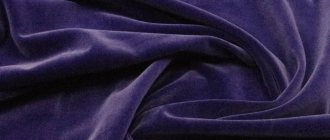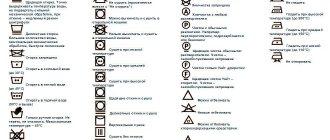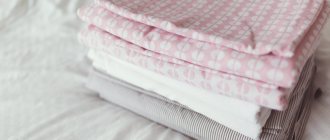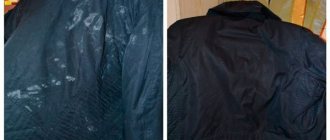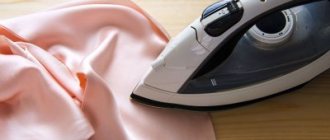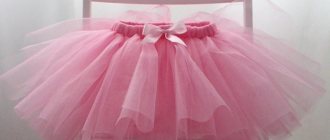How to iron velvet correctly
Clothes made from velvet fabric look elite and noble; curtains and textiles give any setting a touch of real palace luxury. However, even the most favorable impression can be instantly spoiled by folds and creases - they overshadow all other flattering qualities, because a truly aristocratic item will never, ever allow itself such defects. How to save the reputation of this beautiful, but rather capricious material to care for?
Features of ironing velvet
It is preferable to steam absolutely all velvet items rather than iron them - as a last resort, if you do not have a special device, you can stretch the fabric over the spout of a boiling kettle. When using a steam generator, the temperature of the device is set at 90-100 degrees , the slightly dry product is fixed on “hangers”. Processing is done from the inside out, the largest parts are smoothed out first.
If the housewife still has to deal with the iron, the minimum temperature mode is selected. The rules remain the same: the fabric should be slightly damp and turned inside out. You need to iron velvet items through a dampened cotton cloth, lightly and with the slightest pressure, quickly moving along the loops of the fabric - otherwise the product risks stretching.
The ironing principles that apply to velvet also apply to velor fabric.
How to iron velvet without contact with an iron or steamer
There is another interesting (and most importantly, simple and effective) way to smooth out crumpled velvet: it involves applying a kind of warming compress.
♦ Lay out a blanket folded in several layers on a large, flat surface;
♦ Spread a cotton sheet soaked in hot water directly on top. Straighten carefully, eliminating all wrinkles;
♦ Without delay, pin the velvet product to the sheet. Fix the pins at equal distances, first along the length and then along the width of the item;
♦ cover the velvet with a dry sheet. Spread another wet one on top of it.
The resulting “sandwich” is left for the whole night. By the next day the fabric will be perfectly ironed. To eliminate individual, small wrinkles, apply a warm, slightly damp towel to the velvet.
Alternatively, you can perform tricky manipulations with the iron - it will not touch the material directly; folds on the velvet are removed through an “intermediary” in the form of foam rubber. In this case, you will have to iron the velvet parts one by one, and not the whole thing at once, which will require more time and patience.
♦ Take a piece of foam rubber of suitable size. Soak in hot water, squeeze thoroughly and cover with a cotton napkin;
♦ Set the iron to maximum heat. As soon as it gets hot, place it directly on the foam rubber and hold it for a minute until hot steam appears;
♦ set the device aside, and immediately place the velvet item on the foam rubber before it cools down.
This procedure must be repeated until the wrinkles are completely eliminated, periodically moistening the foam rubber and the napkin covering it. It is important to ensure that your hands are always dry when in contact with the material - wet hands may leave marks.
It is advisable to always keep clothes made of velvet fabric hung on hangers to prevent the pile from becoming tangled. Before packing, it is better to turn the item that is about to travel in a suitcase inside out and roll it up - if possible, with a terry towel.
How to iron velor after cleaning?
First of all, it is worth noting that velor cannot be ironed using the usual method. Fleecy fabric does not tolerate such procedures and quickly deteriorates. There is a way out of the situation - steaming. If you don’t have such a device at home, you can use a similar function on your iron. If this is not possible, it is better to take the item to the dry cleaner.
The situation is made easier by the fact that velor products rarely wrinkle. But with a strong spin and improper storage conditions, folds may form on them. How to get rid of them:
- Hang the product on hangers so that it assumes a horizontal position. The main rule is that the procedure is carried out from the wrong side.
- Activate the steam mode on the iron or turn on the steamer itself.
- Walk over damaged surfaces with light movements. Do not bring the device close to the material. There should be a small distance between them.
- If you are afraid for your own clothes, you can steam them using gauze. To do this, gauze is applied to the desired area, and a steam layer is applied on top.
- Ironing should be done along the grain. This will help maintain their density.
Before steaming, you should again refer to the tags on the products. Some things do not tolerate contact with elevated temperatures. For example, some velor robes or furniture covers.
Is it possible to iron velor without an iron and steamer?
If you don’t want to take risks, you can smooth the surface of the fabric using improvised objects. To do this, you need to take a flannelette blanket and fold it several times. Place a damp cotton sheet on the resulting structure. A velor item is laid out on it, carefully secured with pins (in a straightened form), and covered with a dry sheet. The structure is left for 3-4 hours, or better yet, overnight. After this, all wrinkles will be smoothed out and the clothes can be worn again.
What to do if there are iron marks left?
Unfortunately, not everyone understands the peculiarity and fragility of velor, so sometimes this leads to damage. For example, iron marks. It’s worth saying right away that only light yellow spots can be masked. Brown scorched fragments cannot be restored. It is also impossible to restore fabric on a velor sweater or outerwear due to its denser texture. How to remove traces:
- Heat a few tablespoons of vinegar in a water bath, add chopped onion to the mixture, add a spoonful of talcum powder. Mix all ingredients and apply to the stain. After 15 minutes, wash off.
- Grate one onion on a fine grater, apply the paste to the problem area, and leave for 3 hours. Next, rinse the item in water.
- Small stains can be removed with salt and lemon. Pour a spoonful of salt onto the stain, add a spoonful of lemon juice, mix the products and leave them to soak for 3 hours. Rinse everything off with water.
- If a shiny area has formed on the fabric, you can treat it with a steam jet from an iron or steam generator. The main rule is that the device should not touch the material. Continue this action for several minutes, then walk over the problem area with a brush.
If you have doubts about the correctness of the procedure, it is better not to risk it and seek help from professionals.
Velvet curtains: details
Velvet is a material that has a thick coating on the outside with short fibers. Initially, the basis of the fabric was silk. Currently, artificial fiber is used for these purposes. The originality of its exterior is achieved with the help of special types and methods of weaving threads used to make the base and pile covering. When creating curtains, manufacturers use the following types of velvet.
Velor, most people believe that this name describes low-quality velvet with short and infrequent pile. In fact, real velor curtains made from French material are amazingly beautiful and very expensive. Corduroy - a characteristic feature that distinguishes this velvet material is the specific formation of the pile covering, which allows you to obtain a unique pattern in the form of parallel scars. Quite often it is made from cotton. When used correctly in the interior, the direction of strips of fabric can visually increase the height or width of the room.
Panvelvet material has a very original appearance, thanks to its shiny patterned embossing. Velvet devore is a transparent or translucent fabric with a velvety pattern. At the same time, the manufacturing technology is such that the pattern on the pile in the desired places is etched with chemicals until the desired pattern appears.
Alternative cleaning methods
Thanks to the introduction of advanced technologies, velor is now used for a variety of purposes. They sew jackets, tracksuits, dresses, tops, pants, and make shoes. Upholstery and covers for pieces of furniture look elegant and rich.
It is important to care for them properly. To dry clean a velor sofa at home, use a vacuum cleaner. Can be used regularly. The process uses a special nozzle. Particular attention is paid to joints and seams, where debris and dust accumulate most.
This is useful to know
To return shiny fibers to their previous shape, you need to know how to properly clean velor. Places that need to be brought back to normal are held over hot steam for 4 minutes. Outerwear is also cleaned in the same way, except for items made of drape velor, which are difficult to clean at home. It is advisable to seek the services of specialist dry cleaners.
Small particles or pet hair often collect on the fabric, especially during shedding. How to clean lint from a velor dress? The result of using a special tape with a sticky base for cleaning things is effective. You can also walk over the surface with a wet palm.
How to restore velor? The crushed pile is lifted using a massage hair brush or a stiff clothes brush. Puffers are also used for small pets. They just need to be used carefully so as not to damage the material. The jacket is scratched against the pile, then moved in the opposite direction.
Some tips for handling velvet curtains
Before washing curtains you need to:
- Make sure they are suitable for this process. Even hand washing is not suitable for all types of velvet.
- Remove decorative elements such as braid, soutache and frills. All this will need to be sewn into place after washing and drying of the product.
- Place the fabric in a special washing bag.
- Start the wash without spinning at 30 °C in a soft mode, such as “Silk” or “Manual”.
- At the end of washing, you need to get rid of excess water. To do this, wet fabric is placed between terry cloths, which are rolled up tightly. After this, you need to wait a quarter of an hour, spread it on a dry terry sheet and wait until it dries. Before ironing and packing velvet for storage, it is worth considering that: 6. The process of ironing velvet fabric is as complicated as washing, and is carried out without pressure strictly in the direction of the pile.
- The choice of the correct temperature is made according to the composition of the velvet.
- Fabrics with short piles should be ironed without steam, and fabrics with long piles should be ironed with it.
- Before ironing velvet curtains, they must be laid on a soft lining of plush or terry cloth.
- When packing, velvet fabric should not be folded like other materials, as permanent creases and folds may appear. To save it, you need to wind it on a cardboard reel, placing it with the fleecy side inward.
When choosing velvet decoration for window and door openings, it is worth taking into account its appearance, characteristic features and practicality. After all, the presence of luxurious material in the decor does not guarantee the attractiveness of the entire interior as a whole, especially if it is out of place. Velvet curtains should be dry cleaned once every 6 months. Before doing this, it is worth taking a high-quality photo of them so that the craftsmen can understand what appearance the products should have after their work.
At what degrees should I wash?
The beauty of velor is given by the fibers. Therefore, you need to take care of the fabric so that the item retains its original appearance for as long as possible. The fibers of the material can change their direction and wrinkle, so to ensure proper care it is important to take into account the basic rules:
- read what is written on the label. The manufacturer, as a rule, attaches information to the product on how to properly care for it;
- When washing in a washing machine or by hand, choose the correct temperature. The most suitable is 30 degrees;
- the item must not be twisted. You can only squeeze it a little. It is better to let the water drain by laying the clothes on a towel that absorbs moisture and smoothing them out;
- the fabric is strictly prohibited from being machine washed using products that contain bleach;
- When choosing suitable products, you need to take into account that they are intended for delicate products. A good option would be powders for baby products or liquid products;
- You cannot pre-soak velor clothes before putting them in the washing machine;
- When washing by hand, you must rinse the item thoroughly. There should be no soap stains on it. The best way is to rinse under running water.
If you follow all these rules, things will look good and last for a very long time.
This is interesting: 6 ways. How to wash diesel fuel from clothes: at home: fresh, old
How to care for velvet curtains
Velvet is a very popular and stylish material. It is often used to make clothing (velvet women's dresses look especially elegant), shoes, bags and decorative elements. Recently, designers have often used velvet to make curtains, furniture upholstery, textiles and canopies. This is a very elegant and beautiful material, and it is also very comfortable, safe and hypoallergenic. Mites don’t like this material, so you don’t have to worry about them getting in there, and it doesn’t attract dust well. It is perfect for both curtains and home textiles, because velvet allows air to pass through and allows the skin to breathe.
Caring for artificial velor in a car
To care for velor in your car, you can use a special cleaning brush. A sticky roller intended for clothing is also used.
However, the simplest and most convenient way to care for car covers is a vacuum cleaner. In this case, take a soft nozzle. Due to its fleecy structure, dust quickly accumulates on the material.
How to clean velor in the interior? Stains can be removed with a solution of water and laundry soap. Detergents that are used when cleaning carpets are also good. Before using a new product, apply a small amount to a separate area to avoid unpleasant surprises.
Knowing how to care for velor will allow you to maintain the original appearance of your products for a long time.
We recommend that you find out more information in the video:
© 2021 textiletrend.ru
How to properly wash velvet curtains
The beauty and effectiveness of velvet is directly proportional to the amount and difficulty of caring for it. If you do this task incorrectly, the curtains will quickly fade, the pile will become coarse, and the curtains themselves will become thinner. Velvet is a stylish and comfortable material; it is flexible enough to be used to form beautiful draperies, and it insulates well from noise, sun, and drafts.
To maintain its original appearance you need:
- Carry out regular dry cleaning;
- wash the material delicately;
- iron very carefully;
- and store correctly.
Washing velvet at home is quite difficult, so many people resort to dry cleaning. But it is worth remembering one rule: do not put velvet in the washing machine, even at the most delicate mode and low temperature, there is a high probability that one time will be enough to ruin the appearance of the curtains. Most often, dry cleaning will be sufficient for velvet, and general washing is recommended to be done once every six months.
You need to wash in water whose temperature does not exceed 30 degrees. There is no need to twist the fabric; there is a risk of damaging and deforming it. You need to gently wring out the fabric after washing. You should also avoid harsh detergents, especially bleaches. It is very convenient to dry velvet curtains laid out on several towels that will absorb water. It is better not to dry it in the sun, as the fabric may become wrinkled in the form in which it was left after washing.
Washing in a washing machine
Water treatments in a washing machine are not contraindicated for delicate materials. There is a certain algorithm for washing velor in this way:
- an item of clothing is turned inside out,
- If there are buttons and a zipper, the product is fastened,
- complex and old stains are pre-washed, usually children's velor overalls and similar outerwear,
- select a delicate processing mode and an easy ironing function,
- despite the temperature suggested by the technology, it is set at 30 degrees,
- a lower number of revolutions is selected (500-600),
- the spin switches off.
Washing on the wrong side protects the fibers from damage. If the spin mode cannot be turned off, the minimum parameter for this function is set. The fabric can be loaded into the drum together with similar delicate fabrics (velvet, silk, suede, plush).
It is better not to automatically wash jackets made of drape velor. It is enough to wash by hand or even dry clean.
Washing clothes in a washing machine
Washing velor products to shrink them
Synthetic fabric, even if improperly washed, ironed and dried, cannot be reduced in size. Machine processing on the “cotton” mode and 90 degrees will also not reduce this velvet analogue. All that will happen is to stretch it and ruin it so that you can no longer wear the outfit.
The villi will be deformed forever from such a degree, and no amount of resuscitation will return them to their former appearance. The cotton analogue of velvet may shrink slightly if the water temperature is more than 30 degrees.
If the capricious material contains wool, which is extremely rare, then it will be easier to achieve shrinkage. 50 degrees and a long washing mode in an automatic machine are enough to shrink the fibers by 5-10%. In general, if pile velvet is of high quality and 100% natural, it should not shrink. If this still happens after heat treatment with water, the quality of the material can be doubted.
How to wash velor without shrinking?
When the quality and composition of the purchased material is not known, it must be washed carefully. Because it is not clear how it will behave when in contact with moisture.
With viscose and silk filling, you need to wash out the fancy material very quickly; the less time it stays in the water, the better. Then the canvas will not shrink, its structure will not change. To preserve the original appearance of any pile fabric, it is enough to wash it in accordance with the recommendations given above.
Namely, when washing by hand, do not rub or wring out, rinse several times; when using automatic processing, choose a delicate wash with a minimum speed level, without spinning. If you follow all the rules for caring for matter, it will never lose its shape.
To prevent velor from shrinking, it must be washed without spinning.
Ironing Features
It is imperative to direct the iron in the direction of the pile, but not against it. Most often, on most curtains, the manufacturer indicates in what mode and temperature the curtains should be ironed. If there is no such indication or you cut off the label, then choose the very first and gentlest mode, then you will definitely not damage the material. If the curtains have a long pile, then you can use steam, but if it is short, it is better to abandon this mode.
After ironing, the curtains need to be wound onto cardboard bobbins to prevent creases from appearing. If you fold them like ordinary curtains, then creases will appear on them, which are unlikely to be corrected even with an iron. There is no need to wash curtains often; once every 5-6 months is enough. But every week you need to carry out dry cleaning: go over the curtains with a dry brush or a special attachment for a vacuum cleaner, this is enough to remove most of the dust.
Source
Proper care of velor clothing
Removing household stains
- Coffee and tea stains . Soak clothes in soapy water for 30 minutes.
- Exposure to bad weather . If dirt gets in, leave clothes to dry. Once completely dry, remove any dirt deposits using a suede brush (it has rubber bristles). Be sure to do the washing.
- Oily spots . On dark fabric, remove stains with the pulp of black bread; for light-colored clothes, white bread is suitable. You should not use a crust, as it will erase the pile and lead to the appearance of voids.
- Chewing gum . To remove stuck gum, apply an ice cube or a package of frozen food to the affected area. When the gum becomes hard, carefully remove it using a sharp object.
- Wine stains . To solve the age-old problem, crush one Aspirin tablet to a powder and dilute with a glass of water. Dampen a cotton swab with the solution and rub the problem area until the stain disappears completely.
- Greasy . Steam treatment will help restore shiny and greasy areas to their original appearance. Bring the steam source to the problem area and hold for 3-4 minutes. After the procedure, comb the surface with a suede brush in the direction of the pile.
Before cleaning, test the effect of the product or solution on a hidden area of the fabric.
Washing velor clothes
Velor items can be washed manually and automatically. When performing this operation, observe the following requirements:
- Water temperature – no more than +30 degrees;
- When machine washing, you must set it to “manual” or “delicate” mode;
- Use only mild products that do not contain aggressive substances or bleach (for example, liquid powder or gel);
- Clothes are not soaked before washing;
- In automatic mode, set the spin cycle with a minimum number of revolutions (no more than 600), in manual mode - well, twist the clothes, but only squeeze them lightly to remove excess water;
- Do not wash velor (velvet) unnecessarily; if stains or other contaminants appear, resort to the cleaning methods described above;
- After hand washing, rinse the clothes thoroughly under running water to remove any remaining soap solution and avoid the formation of streaks;
- To load the drum, wash velor clothes together with other delicate fabrics that have similar care instructions.
Note:
Jackets and jackets made of thick drape velor require washing under special conditions, so it is better to have them dry cleaned.
How to dry and iron washed clothes?
It is necessary to dry velor products naturally in a horizontal position, in a ventilated area and away from sources of artificial heating. Direct exposure to sunlight is not allowed.
Ironing is performed using steam, so the iron must be equipped with a steam function. The processing process has the following features:
- Clothes are ironed only from the wrong side, this will preserve the integrity and position of the pile;
- To reduce lint creasing, place a terry towel under the product;
- Do not press the soleplate of the iron against the clothing;
- Products are ironed along the grain to preserve the structure of the fabric;
- While processing, pull and secure one end;
- A dress or skirt can be hung on soft hangers and steamed using a steam brush.
After the product has dried, comb the lint with a suede brush.
Store velor clothes in a dry closet on hangers. For long-term storage, use a breathable fabric cover that will protect the product from dust.
For velor clothes, you can choose a stylish T-shirt from our online store. The catalog includes men's products: black T-shirts, blue, purple, light blue, with patterns, stripes, etc.
Is it possible to iron velvet
The label on the clothing tells you whether the wrinkled velvet item will be ironed. When there is no such hint, you need to carefully examine the wrinkled fabric. You may not need an iron.
Light bruises can be easily dealt with in the following ways:
- Hang clothes on a hanger. It will straighten out under its own weight.
- Place slightly wrinkled clothing in a room with high humidity (the bathroom after a shower is suitable).
- Hot steam helps get rid of individual bruises. It straightens deformed areas and refreshes the color of the item by holding it over a bowl of hot water with the nap facing down.
- Ironing with a feather pillow noticeably renews and transforms the noble material. The wet product, turned inside out, is placed on a pillow previously covered with white linen cloth. The iron is passed over it with light and quick movements. Strong pressure with an iron leads to the opposite effect.
Setting the temperature on the iron
If you are using an iron, you need to set the minimum temperature setting. Heating the device to 100 °C is optimal. Try not to press the sole of the iron close to the surface, but rather work the material at a short distance.
Gentle cleaning
Proper care of velor means removing dirt and getting rid of shiny areas. The upholstery of chairs or sofas can be easily cleaned with soap and water.
Apply the solution to the stain with a soft sponge and remove it from clothing or upholstery with gentle movements. If you need to clean fabric on furniture, it is advisable to use a vacuum cleaner with a brush attachment. Gently move it along the surface in the direction of the pile.
You can also buy special rubber brushes. Greasy areas can be easily tidied up with steam. The product can be brought to a kettle or pan of boiling water and held for three minutes. Then comb the item in the direction of the pile. You can use a special velor cleaner. It is sold in stores.
How to iron a velvet dress
To make the result pleasing to the eye, you need to follow several recommendations when ironing your dress.
- Make sure the fabric of the dress is slightly damp.
- Iron the dress from the wrong side.
- Firmly secure the dress on one side and pull it on the other with your hand.
- Iron with quick movements, without pressure, through a damp cotton cloth.
- Try to move the iron along the loops of the fabric to avoid stretching the material.
- After ironing, air the dress until completely dry.
When ironing a dress, the sequence of processing of the parts is important. First, iron the largest parts - the skirt and bodice. Next come pockets, sleeves, shoulders, collars.


